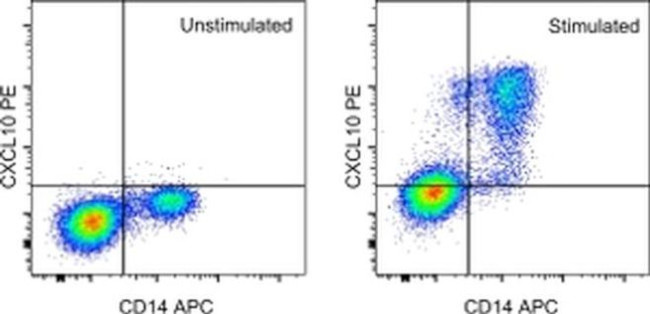Search Thermo Fisher Scientific
Invitrogen
CXCL10 (IP-10) Monoclonal Antibody (4NY8UN), PE, eBioscience™
FIGURE: 1 / 1
CXCL10 (IP-10) Antibody (12-9744-42) in Flow

Product Details
12-9744-42
Species Reactivity
Host/Isotype
Recommended Isotype Control
Class
Type
Clone
Conjugate
Excitation/Emission Max
Form
Concentration
Purification
Storage buffer
Contains
Storage conditions
Shipping conditions
RRID
Product Specific Information
Description: This 4NY8UN monoclonal antibody reacts with human CXCL10. CXCL10, also known as Interferon Inducible Protein-10 (IP-10), is a member of the CXC family of chemokines. It is secreted by monocytes, epithelial cells, and endothelial cells in response to IFN gamma or other pro-inflammatory cytokines and stimuli. CXCL10 signaling is mediated by the G protein-coupled receptor CXCR3, which is expressed on activated T cells and plays an important role in directing the migration of T cells, especially during Th1 responses. In addition to its chemotactic functions, CXCL10 is a potent inhibitor of angiogenesis and tumor growth and modulates expression of adhesion molecules. Elevated levels of CXCL10 are observed in response to allergic inflammation, various infections, and Alzheimer's disease.
Applications Reported: This 4NY8UN antibody has been reported for use in intracellular staining followed by flow cytometric analysis.
Applications Tested: This 4NY8UN antibody has been pre-titrated and tested by intracellular staining followed by flow cytometric analysis of stimulated normal human peripheral blood cells using the Intracellular Fixation & Permeabilization Buffer Set (Product # 88-8824-00) and protocol. Please refer to Best Protocols: Protocol A: Two step protocol for (cytoplasmic) intracellular proteins located under the Resources Tab online. This can be used at 5 µL (0.125 µg) per test. A test is defined as the amount (µg) of antibody that will stain a cell sample in a final volume of 100 µL. Cell number should be determined empirically but can range from 10^5 to 10^8 cells/test.
Excitation: 488-561 nm; Emission: 578 nm; Laser: Blue Laser, Green Laser, Yellow-Green Laser.
Filtration: 0.2 µm post-manufacturing filtered.
Target Information
IP-10 (interferon-gamma induced protein 10 kD; in mouse, also called cytokine responsive gene 2, Crg-2, or mob-1) is a highly inducible, primary response gene that belongs to the CXC chemokine superfamily. It was first cloned in 1985. The biological functions of IP-10 are still unclear. Like Mig, IP-10 has no activity on neutrophils. Its functions include stimulation of monocytes, natural killer and T-cell migration, regulation of T-cell and bone marrow progenitor maturation, modulation of adhesion molecule expression as well as inhibition of angiogenesis. Mig and IP-10 share the same receptor, CXCR3.
For Research Use Only. Not for use in diagnostic procedures. Not for resale without express authorization.
How to use the Panel Builder
Watch the video to learn how to use the Invitrogen Flow Cytometry Panel Builder to build your next flow cytometry panel in 5 easy steps.
References (0)
Bioinformatics
Protein Aliases: 10 kDa interferon gamma-induced protein; C Cmotif chemokine; C X C motif chemokine; C-X-C motif chemokine 10; CC motif chemokine; CCmotif chemokine; chemokine (C-X-C motif) ligand 10; CXC; CXC motif chemokine; CXCL; gamma IP10; Gamma-IP10; H-IP-10; interferon-inducible cytokine IP-10; M-IP-10; protein 10 from interferon (gamma)-induced cell line; small inducible cytokine subfamily B (Cys-X-Cys), member 10; Small-inducible cytokine B10
Gene Aliases: C7; crg-2; CXCL10; gIP-10; IFI10; INP10; IP-10; mob-1; SCYB10
UniProt ID: (Human) P02778
Entrez Gene ID: (Human) 3627

Performance Guarantee
If an Invitrogen™ antibody doesn't perform as described on our website or datasheet,we'll replace the product at no cost to you, or provide you with a credit for a future purchase.*
Learn more
We're here to help
Get expert recommendations for common problems or connect directly with an on staff expert for technical assistance related to applications, equipment and general product use.
Contact tech support

